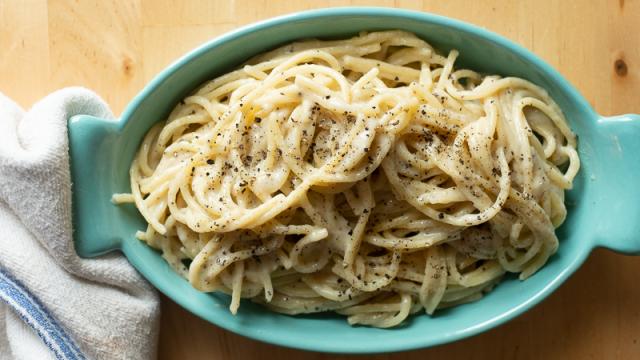If I could only own one electric kitchen gadget, it would be an immersion blender. Mine sees near-constant use, making short work of everything from mayonnaise to lemon curd; it’s never met a lump it couldn’t smooth out. Still, I’d never have guessed that this trusty machine would solve my cacio e pepe woes for good.
[referenced url=”https://www.lifehacker.com.au/2018/06/how-to-make-perfect-lemon-curd-in-the-microwave/” thumb=”https://i.kinja-img.com/gawker-media/image/upload/t_ku-large/rgfmfiuakyp1t1wvwld4.jpg” title=”How To Make Perfect Lemon Curd In The Microwave” excerpt=”No matter how many flawless custards or mirror glazes you’ve made in your life, some culinary techniques just seem to invite disaster, especially those that hinge on precise temperature control. If you need to evenly heat a delicate substance to a precise temperature, the microwave might seem like a horrible choice — but it’s often the best tool for the job.”]
I’m a confident and accomplished cook, but the subcategory of Italian pasta dishes that call for an emulsion of hard cheese and pasta water has always eluded me. Cacio e pepe is my pepper-flecked white whale: I am absolute trash for pecorino romano, but it resists emulsifying in a way that Parmesan does not.
Until recently, I thought I was doomed to a lifetime of sub-par, clumpy noodles, but was saved by the incomparable Deb Perelman of Smitten Kitchen. As she learned from Italian chef Flavio de Maio by way of Elizabeth Minchilli, the secret to not screwing up cacio e pepe is blending the cheese with a bit of cold water to make a paste. Here’s how to do it.
Choose your favourite cacio e pepe recipe; this will work with any of them. While you wait for water to boil — well-salted, of course — measure out the cheese into a container that you can get the head of an immersion blender into.
Add a lot of black pepper and a tablespoon or two of cold water, stick in the blender, and blend into a thick, smooth paste. (You can also do this in a food processor or blender.) Thirty grams of cheese can take up to a tablespoon of cold water, so add more if you need to.
Cook the pasta as directed, reserving a cup of cooking water before draining. Immediately transfer the pasta to a big mixing bowl and add most of the cheese paste. Dribble in a bit of pasta water and toss the noodles vigorously, adding more cheese paste and/or cooking water as needed, until you have a thick, smooth, glossy sauce. Serve immediately.
The possibilities here are limited only by your imagination and appetite for cheesy carbs. I see no reason this technique wouldn’t work with, say, a bunch of egg yolks and pork fat thrown in for carbonara — or even a mess of cheddar and Gruyère for the purest, cheesiest mac and cheese of all time.
The stick blender trick is powerful knowledge; wield it responsibly.

Comments